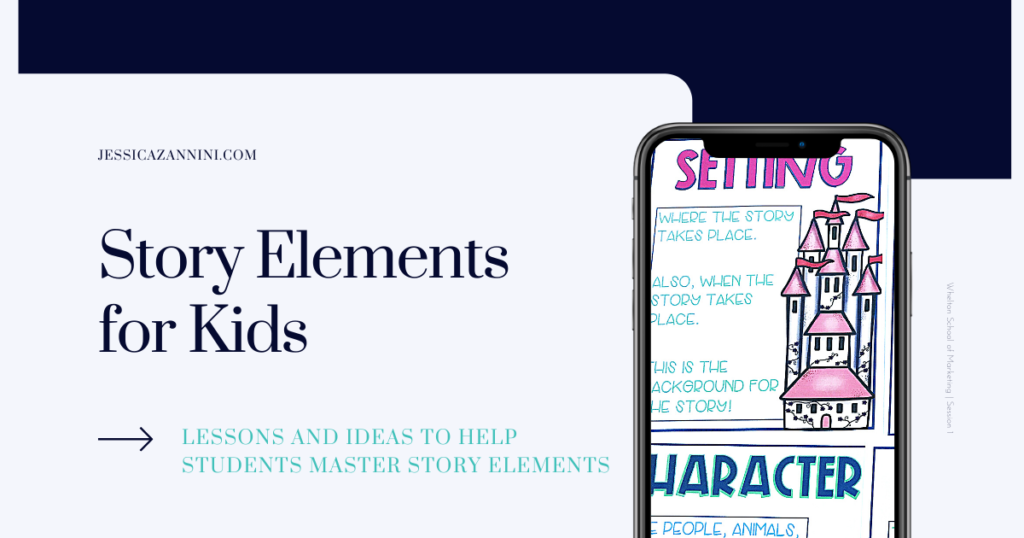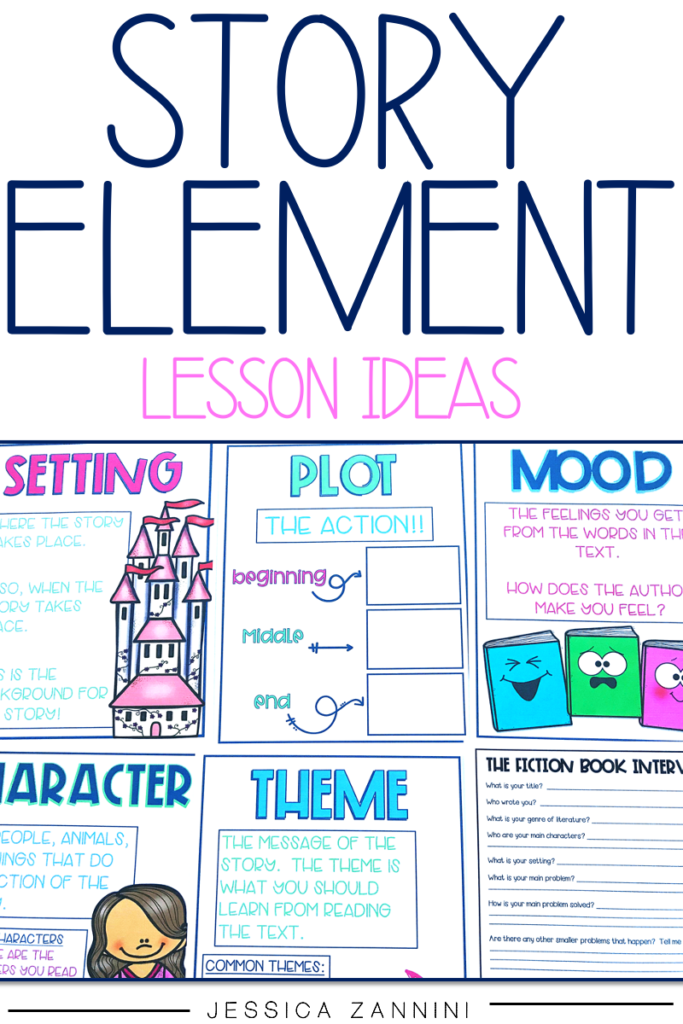
Having a clear understanding of story elements is one of the keys to reading comprehension of fiction texts. The more practice students have, the better they get at quickly recalling the terms and being able to visualize what is happening.
Story Elements Graphic Organizers and Games
Story elements can be taught a variety of way. Using games, technology, graphic organizers and worksheets will help guide readers in finding these key elements within a story they are reading.
Story Elements Anchor Chart #1: Teaching Character Ideas:

- The What a Character Poster focuses on specific aspects of a character. Have students draw a picture of a character from the books. List details that they read or can infer from the story.
- FlipGrid Character Mysteries – Students tell 3 facts about a character and the others guess which character is being described in a Flipgrid video.
- Character Charades – Students act out a specific character based on their character traits.
- Character Compare – Use a Venn Diagram to have students compare themselves to a character in the book. You can also use this to have them compare characters in the book.
Story Elements #2: Teaching Setting Ideas

- A Setting Map is a great way for readers to show the details they have comprehended about the time and place of the story.
- Setting Lists Game: In one minute list as many things as you can think of that one could see in the setting. You can continue this to other senses such as smell, taste (what/where do they eat), feel, and hear. Do this as a small group or independent lesson.
Story Elements #3: Teaching Plot Ideas:

- A Story Map allows readers to identify all of the elements within one story.
- A Plot Outline is for more advanced readers. This outline allows readers to look at the big ideas of the text. This is a great guide to use before summarizing a story.
- Problem/Solution Chart allows readers to identify the problem of the story, find the solution, and then describe how the story moved from the problem to the solution.
Story Elements #4: Teaching Mood and Theme Ideas:

- Use Theme and Mood Graphic Organizers guide readers to finding these key elements.
- Story Emojis – Have students create Emoji puppets to hold up during a reading session. Use these to show the mood of the story.
- Mood Review – Have students review the book through Mood. What was a sad moment in book? Scary? Happy? etc.
- Theme Debates – Theme can be a tough concept to grasp. Take a list of themes and have the students determine if the book fits that theme. For example, you give the theme of “Family.” Have the students defend whether that theme would fit the book and tell why or why not.
Story Elements #5: Teaching Summarizing Ideas
- Summary Poems: Write Acrostic poems, Haikus, or Cinquain poems to summarize a book. You can use these poetry templates to guide students. in writing these poems.
- Book Reviews – Have students write book review of a book. This can take many forms. One that students loved was to do a directed drawing and write the review on the drawing.
- The Fiction Book Interview allows readers to “interview” the book to get the story elements. Have students pretend that the book could answer the interview questions.
- Story Element Experts: Divide the class into groups and have each group focus on being experts in one of the elements
I want to learn more about Story Element Graphic Organizers.

Story Elements Anchor Charts
Use anchor charts and posters to allow students to refer to the terms until they fully understand the elements. Be sure to include the elements of setting, character, plot, theme, and mood.
- Setting – tells the “where” and “when.” The setting sets the background of the story. Understanding where the story takes place and the time period or season can help you visualize the story.
- Character – tells the “who.” Who is the main character in the story. Who is the story mostly about? There are also minor characters. These are the other characters in the story that the main character interacts with.
- Plot – describes the “what.” What is happening in the story? Think the beginning, middle and end.
- Theme – is the “why.” Why did the author write this story? What was the author’s purpose. Did the character learn something in the story? Some common themes are friendship, family, bravery, and perseverance.
- Mood – The mood answers “how” you or the characters are feeling.
What to learn more? Click here to grab a copy of the posters and story element graphic organizers.
Need great books to read to teach these Story Elements?
Try these fictional narrative mentor texts.
Check out these Middle Grade favorites.
Create Book Clubs for Your Next Novel
Let students choose the books they want to read while you teach the standards with Novel Notebooks. This is great way to motivate readers with their own choice while teaching important skills.
I want to learn more about Novel Notebooks.

Leave a Reply